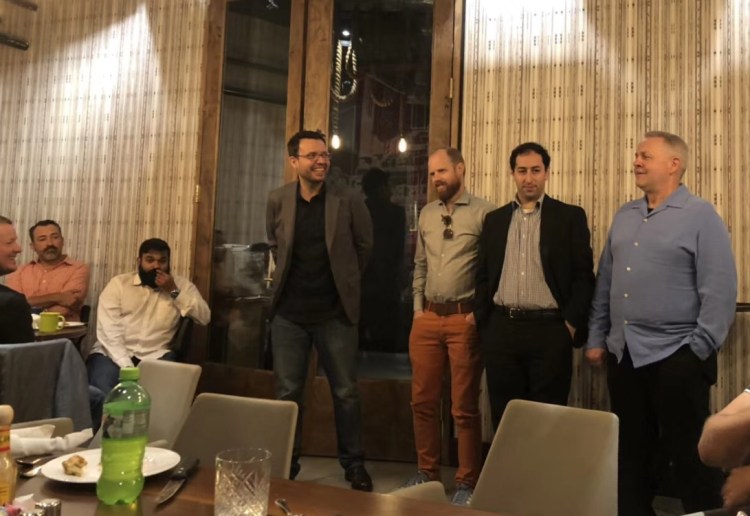It’s been awhile since OnLive came out of stealth in 2009 and promised to disrupt the game consoles with a revolutionary cloud-gaming service, where remote data centers could compute the games rather than a user’s machine.
That rosy future didn’t quite happen, and Sony acquired OnLive’s assets in 2015 and shut the service down. But the promise of disruption is still out there.
We talked about the future of cloud gaming at a breakfast sponsored by Akamai during the recent Electronic Entertainment Expo (E3). Just as movie and music services have moved to the cloud, companies such as Sony (via PlayStation Now), Blade via its Shadow, and others have begun offering games that are served and played via cloud services. Distant data centers process the games and images are passed down as video to players, who interact with the content without downloading the games first.
Gamers haven’t yet flocked to these services, but cloud delivery is getting more efficient, and services such as 5G routers could make the technology work better. Our speakers included Jacob Navok, CEO of Genvid Technologies; Chris Early, vice president of partnerships and revenue at Ubisoft; Nelson Rodriguez, head of media partnerships at Akamai; and Doki Tops, CEO of Utomik, which has 800 games available via progressive downloading.
Here’s an edited transcript of our conversation.

Above: Panelists Chris Early, Doki Tops, and Nelson Rodriguez.
GamesBeat: I started covering cloud gaming very intensively with OnLive. I wrote some of the first stories on OnLive, and then some of the last stories, when it went away. Nearly a decade after that, what are the lessons of that?
Nelson Rodriguez: That it’s hard. [laughs] What’s interesting about the panel is that I think the panel represents the three key questions for cloud gaming. When I talk about cloud gaming I’m talking about remote control games, server-based games. The three questions are: will the content be any good? Second, will the business model work? Is the price right for consumers without bankrupting the publishers? And third, does the tech work? Can it get under 200 milliseconds latency? Does it feel like your controller’s broken?
I don’t think there’s a question about whether customers want it or not. To me, that’s different from VR. There’s a question about whether the average person wants VR. For cloud gaming, there will never be a question about this. People will always prefer to immediately get what they want. The question is just, can we do it? Will publishers deliver good content at the right price and will the experience be viable? That’s what I’m curious to understand.
Jacob Navok: You hit what I was going to hit. People mistake the point of cloud gaming as being technological, just overcoming hurdles. It’s about, do you have content that justifies the investment into this technology, and can you create a business model that allows the industry to profit off something new? If you treat cloud gaming as, now I can take my console and put it in the cloud, you’re doing it wrong. If you’re going after that core customer, they already have an Xbox or a PlayStation. They don’t need something like that.
Furthermore, if the benefit of having a massive server farm is to be able to allow people to have new experiences, why aren’t you utilizing that? Why are you taking product built with local hardware in mind and just putting that on a server? Design new forms of content that are appropriate to the cloud and monetize it with business models that are appropriate to the cloud. Why take games that were packaged and built to be put on discs and throw that same business model to the cloud? Why would you even destroy that value by throwing it away in favor of an all-you-can-eat subscription model?
If the vast majority of the game industry these days monetizes through engagement and microtransactions, why would you not create business models for streaming that allow people to do that? It comes down to, can you create services around content design and business model design that fundamentally differ from what’s come up until now. That’s the opportunity that cloud gaming brings.

Above: PlayStation Now on PC.
Doki Tops: I don’t necessarily agree with all of that. For me, the fundamental challenge of the cloud, the reason some of these developments never materialized — we’ve said it’s going to be cheaper because we’ll get more servers for more compute. But then the experiences ask for more and more compute as we go. Where we agree is, why isn’t anyone making a way more expensive experience that requires the power of four Xboxes, and then you use the cloud to give you that experience?
That was my dream, but I have a very technical background. I know how much engineering goes into games that just use the power of one Xbox. I know a lot of engineers that work on how to get more from that one console and get better results. Diminishing returns set in. When you have two Xboxes, the picture you can render doesn’t necessarily become twice as good. The user experience doesn’t become twice as good.
When we’re at a point where we can truly have content pipelines that can generate photorealistic art at a reasonable price, and have engineers to do all that stuff — up to that point I don’t think cloud will be used to create emerging new experiences. If you go to the Army or all the B-to-B businesses, cloud is already being used. It’s one of the most impactful things on how you can run your entire business. If you have 400 people on a project you want to run that in the cloud, because all your security problems are solved. All your licensing problems are solved. You don’t need more PCs. You need even less.
What I do find fascinating with the cloud is, we’re in the business of subscription gaming. As soon as you have games that are indie or not as high end, that starts to make more sense. We already give instant gratification. You get people complaining, “I want to play this on my Mac,” and a developer has to do an entire port. Then cloud becomes very interesting. It opens up more platforms.
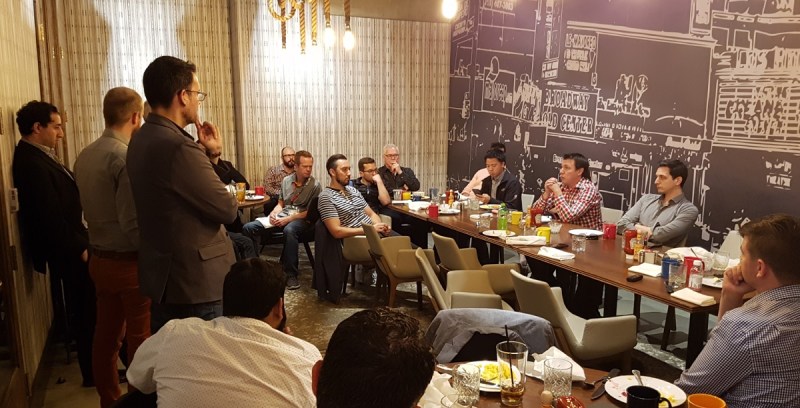
Above: The VentureBeat-Akamai cloud gaming breakfast at E3 2018.
Chris Early: I worry that — part of what you’re describing assumes a linear progression of game experiences. They don’t have to get more complex.
Navok: Right. It’s about new experiences. Minecraft showed what you could do with different graphics and new gameplay.
Early: We have 150 million HD gamers out there today. That’s our primary addressable market. We know that there are close to 2 billion people playing games. That’s a big gap between those two. One of the things we’re interested in is, how do we address that market? How do we get to the people who maybe can spend a bit of money a month to have that access who’ve never bought a console, and don’t have the investment or desire to build their own high-end PC? How do we increase that total addressable market size with people who maybe were gamers at one time, but they aren’t buying the latest consoles anymore because they have whatever else going on?
It’s not about the game necessarily being super more complex or anything else. I can make the same game and now I suddenly have access to 10 times the market size, if we can figure out how to make that easy. That’s pretty good from a business standpoint.
Tops: That’s what I’m saying about other platforms. If you can go to a lower-end box, all of a sudden….
Early: I think the point is, also, once you’re doing that, will new forms of entertainment emerge? Absolutely. Are there new business models that emerge? Absolutely. We all saw that happen in mobile. Everyone started out saying, “Oh, now I can do a premium experience on mobile and someone will pay $10” for it.
Navok: At Square Enix, we were the first ones trying to do that. We ported Final Fantasy games for $10. If you look at the revenue Square Enix makes now in mobile, it’s all from free-to-play. Not those Final Fantasy games.
Tops: What I found fascinating about OnLive, I remember the E3 show. It was pre-Twitch. You could just watch everything. The implications of cloud gaming, outside of just playing games remotely — with all the live streaming that’s going on, you could do some really crazy stuff. I talk to people who work in VR. You could create a virtual arena where you’re sitting in your VR headset and watching the game.

Above: Steve Perlman, founder of OnLive, at GamesBeat conference in 2010.
GamesBeat: Maybe OnLive should have become Twitch.
Tops: But the premise of cloud gaming is that in a way, you’re an observer. You’re not a player. All the parts and the costs and the high-speed rendering is somewhere else. I can go into a game in my VR helmet and watch it. VR actually requires more framerate depending on the experience, but not so much when it’s static, when you’re not moving around. That’s an interesting possibility, the chance for people to hop into an experience from any device. I can take my Samsung VR and not use it to play games, but to watch somebody else play.
Navok: You said something very interesting there, that OnLive could have become Twitch. When I left Shinra and started my company, I decided that instead of focusing on cloud gaming, I was going to focus on interactive broadcasting. What’s the market that exists today? What’s the market that will exist in the future? But the challenge that I saw — this was the challenge that I had at Shinra that I spent most of the decade on in cloud gaming — was that developers didn’t understand how to generate content that could take advantage of streaming.
Yet if we look at the broadcast ecosystem today, streaming is happening. Adding bits of interactivity to it enables developers to think about how you can create experiences that are brand new. I flipped the pyramid on the work I was doing. I decided to go from the Twitch route and create content directly on Twitch and YouTube, which steadily taught developers who were working with us how to create streaming experiences.
What’s fascinating is, when I started this company two years ago, some of the first questions we got were, can you get over the latency? Can you get this back to zero latency? If you can do that, the difference between interactive streaming and cloud gaming is effectively zero.
GamesBeat: Genvid raised about $6 million in April, right?
Navok: Yes, we did, for a total of $10 million so far. I think you’re right, though. There will be evolving business models. But we’re still stuck at — Fortnite shows us that there are tons of mobile gamers — everyone in this side of the industry said, “Well, they’re not real gamers. They’re not interested in this kind of stuff.” Maybe we’re wrong, or at least half wrong. Somewhere between 2 billion and 150 million, half of that is a pretty good margin to be wrong about. You can still make some money there, just getting the games we have today into more people’s hands.
Tops: If you look at Hearthstone, that’s being played on mobile and everywhere else.
GamesBeat: I think 80 million of Fortnite’s 125 million gamers are on mobile.
Navok: It’s kind of an HD game. It’s a complicated, core game. It’s not just match-three game.
Early: The game industry has come a long way on the challenge of how you get a great game experience on a phone. Five years ago, if you said that a first-person shooter, any good shooter — a boring experience that people threw away after five minutes, those were the first shooters on mobile. That’s a hard thing to do.
Navok: There’s a mistaken assumption that the game industry shifts. The game industry doesn’t shift. The game industry expands. If you look at the history, from arcades onward, it’s like geological strata. The arcades still exist in Japan. It’s a $5 billion business. Console still exists. PC online still exists. Mobile still exists. Cloud will still exist. Cloud will expand the industry. It doesn’t replace it.
Early: And that sounds great to me. More of our games in more people’s hands.
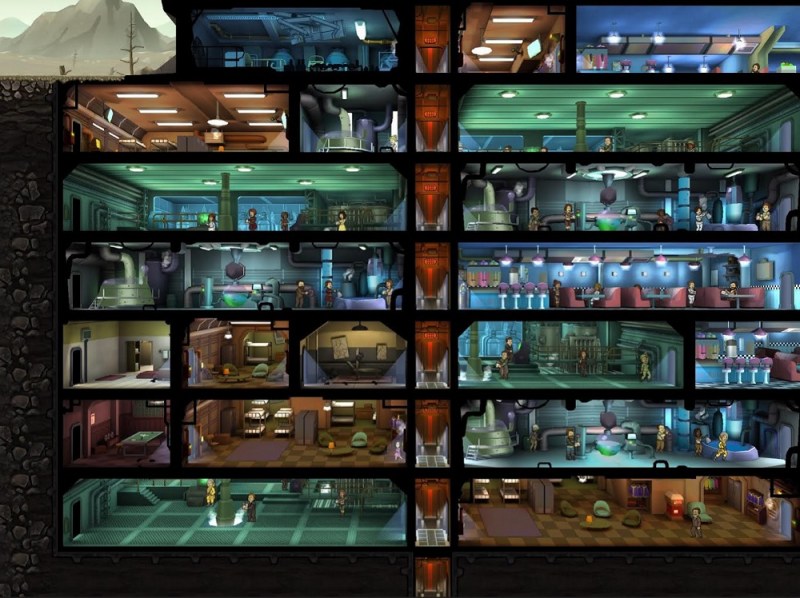
Above: My Vault in Fallout Shelter has some dead bodies in it.
GamesBeat: I think about how E3 is an example of what’s happening with consumer behavior. It used to be a show where you made an announcement and six months later the game came out. Bethesda, back in 2015, announced Fallout Shelter and said, “By the way, you can download this now.” They got 12 million downloads in a day. Thanks to streamers, E3 itself is now getting billions of views in a week or two. That instant gratification is what gamers want now, because they have nanosecond attention spans. We’re heading in this direction toward immediate gratification for consumers, and cloud is something that can deliver that.
Michael Sudin, audience: You guys are talking about the future, but we’re doing this today. You had three questions: price, does it work, and do you have content? The way we’re doing content [at Blade Shadow] is we’re giving you a Windows PC. Working with Microsoft, we have licenses, and you can install whatever you want to play. If you want to play Fortnite, free-to-play games, go for it.
Tops: What’s your price point?
Sudin: $35 a month.
Tops: $35? I’m not even subscription. If I can do that in the cloud….
Rodriguez: Aren’t we talking about two different things here, though? One is a delivery technology and one is a business model. We should keep things straight here. Let’s talk about a delivery mechanism, a replacement for discs, or let’s talk about a business model. They’re not the same thing.
Sudin: $35 buys you a really powerful PC and the cloud. That’s what we give you. You can play the latest game that comes out tomorrow, use apps today, or whatever you want. You have content.
Navok: For you, the consumer decides between buying a $400 console, or a $1,000 PC, or a $35 per month service. Each one of those gives them access to play their games.
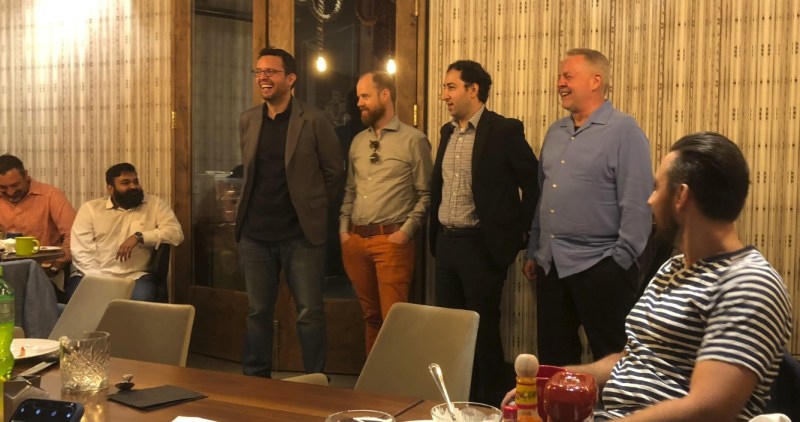
Above: Cloud gaming panelists (left to right): Nelson Rodriguez of Akamai, Doki Tops of Utomik, Jacob Navok of Genvid Technologies, and Chris Early of Ubisoft.
Sudin: In terms of monetization, the reason we can deliver high quality is because we have our own servers. That brings our price point down significantly from other platforms. You can run this on AWS, but it doesn’t have the hardware capabilities. It doesn’t have the optimizations we have. We can get it to work, and we have the price point.
GamesBeat: How do you address a larger part of the market? You can find a niche and build a startup there, but how do you reach the scale where people are going to care about it?
Sudin: Today we’re going after the high-end gamer. We have to win over those influencers, those core gamers, and change the mentality. We started with a skeptical view here today. The most frequent question we have on our website is, “Does it work?” People want to buy it.
Early: One of the things you’re getting at is the cost of service, when you think about games. Your cost to serve to the player is $35 a month, arguably plus some amount more, from an overall standpoint. The better companies get at providing the capability to run that, the more market that opens up. Right now, today, the person deciding, “Hey, maybe I will play Assassin’s Creed again,” because they enjoyed the first one and then they had kids or whatever — I think it’s a price question too. There’s obviously price elasticity in the market. If you can drive your costs down to $5 a month, I have a much larger market that would very much appreciate it.
Audience: Right now that price point is for the high end. Those cards are going to get old. We have excess capacity during the day. We don’t necessarily have to hand you a new graphics card every time you log on, but we do today. All of these things can be optimized. Today we’re trying to get a foothold in the market, expand, build a brand, and then do all of those optimizations. They’re completely possible and they can drive our costs far down, especially if you’re playing older games, or just doing something like word processing.

Above: You can use the Shadow device to log into the Shadow cloud gaming service.
Rodriguez: If you can get to the point where you’re dynamically allocating a server or a computing device in the cloud, you could lower the cost to serve that. Other folks are doing that too. GeForce Now is out there with their systems and things like that. That’s great. So why aren’t people all over it?
Tops: We have our own delivery model, which also gives instant gratification on a connection that also runs cloud games. That’s a funny thing. I’m a bit of a schizo here. I have technology that just uses the compute that’s available, the compute people have in their pockets. It’s insane, right? It’s double a PS3 now. That’s why PUBG can run on all these systems. I’m just looking at a place like, where do I need it? Where can I use it? There are instances where I can use this compute and still give an instant gratification solution.
My view of it is the costs are real. I’ve been doing modeling on this business every year. Every year I say, “Let’s do it again. Let’s do it again.” I want it. I might sound negative, but I want this to work.
Rodriguez: Right, because you offer a great thing. You offer a subscription business model at a very short wait time to be able to play.
Tops: Right. I want to keep that price reasonable. The $5 mark, that’s a magic mark. When I talk to these guys and say, “I have my subscription service, but I’d like to deduct my distribution costs, and I do cloud gaming,” he just runs off into the distance. “Yeah, you can pay for that.” But if I have to pay for that, that’s why all of these services — EA basically bought a negative business. They were not making money. That’s not a good thing for cloud games. I’m trying to figure out models where we can make it work, because the delivery model and the business model, they are connected to each other.
Early: I don’t buy that at all. Right now you can do a subscription business model, download these games — Microsoft has a service just like that. It doesn’t have anything to do with cloud gaming.
Rodriguez: This is why I think they’re related. Microsoft’s Game Pass, Akamai loves that. To download 100,000 games if you want to, and we’ll charge them for it? There’s no way that’s going to be a sustainable price.
Navok: You’re saying replacing a six-gigabyte download with 5Mbps constant for 40 hours is going to result in the same thing.
Tops: This is where it gets broken. I really want to explain to this people. This is where delivery becomes different. If you do cloud gaming, you have 100,000 people online. Those 100,000 people create 100,000 unique streams. This means, inside your entire network, there’s zero caching. All of a sudden you need a pipe that’s 100,000 times 5Mbit. I think 5Mbit is being very positive. High framerate, good fidelity, competitive latency, that’s probably more like 7-12Mbit to get a great experience. Maybe even 15. The pipe that you need, and you actually pay for the pipe—the bandwidth is nice, but if you need a concurrent pipe, it becomes really expensive at scale.
Audience: Parsec is in the cloud gaming business, in that our encoder and streamer powers a cloud gaming service through our business. But we don’t believe that right now is the right time for cloud gaming. The economics do not work. It doesn’t work, because if you want to be playing constantly on this system — for a lot of reasons you said. If you get hundreds of thousands of people on this pipe, it’s a problem. There’s no caching.
But I do think the point you’re making about content is really the most important thing. The best experience is going to be a situation where I’m watching Rogue One and I want to finish Rogue One as a game. The distribution model of cloud gaming will allow for that. Whereas the current model doesn’t it. But we have to get to content like that.
Navok: That’s a very important point, but I want to connect it to the business model question, because the question of profitability and cost here is an equation of what you’re charging the consumer and what they’re willing to pay. If you resolve content that is new, that creates monetization thresholds that are larger, and you’re not destroying value by keeping everything under a cap and setting a premium fixed price, then you will be able to justify the cost.
If you can create whales that are paying you $300 a month for your games — and God knows we’ve read some amusing articles around Final Fantasy Brave Exvius recently, the thousands of people paying thousands of dollars for that mobile title — it’s possible to do this. You’ll be able to generate profit. But I agree that today, the business model and the content model are not being charged at a threshold that can create profitability.
Rodriguez: The way that Nvidia licenses work, generally, is that you can’t use GeForce cards in the cloud.
Navok: That’s partially our fault. I went to Jensen Huang and said we were going to do that, and then they changed the licensing rules.
Rodriguez: You’re against the terms of service unless you have a special licensing agreement with them. If you use P5000s, that’s $6,000 a card or whatever it is, and they have the same output as a 1080. It has to be dedicated to each gamer. The expense….
GamesBeat: We have all these arguments right now about why this may or may not work. But the leaders of the industry are actually starting to communicate that we’re doing stuff here.
Early: For us it’s a question of addressable market. We believe that there are plenty of people who are willing to play the games that we make today if we can deliver it into their hands in a way that they’re willing to pay for. Today, our 150-million customer base buys our games, and as we all know here in this room — we’ve all got friends who stopped playing games because they didn’t buy the last console or didn’t upgrade their PC, who still reminisce about games. We saw that about a game we announced recently where Star Fox is going to be a character. There was an amazing outpouring of nostalgia that created at the press conference. They’re there.

Above: Utomik has 800 titles available for download.
GamesBeat: That’s where we want to get, but is there something that happened to make them less skeptical about this equation that Nelson brought up?
Tops: 60 gigabytes, if you can get it pretty cheap, that’s 30 cents. The distribution costs, cost of deliver, 30 cents, one time only. Versus $35 a month? That’s a gap. It doesn’t need to come to that price, not by a long shot, because there’s other economics there. I think there’s already context in which, for me, cloud gaming is working. Otherwise I wouldn’t be here.
Early: There are more people talking about cloud gaming and the ability for us to create that addressable market, whether it be Microsoft’s service, whether it be your service. The challenge we have is that those are all unprofitable business models for us as a publisher. We have to figure out a way that we can take advantage of that type of distribution or increase in the addressable market. We have to find a way to monetize.
Tops: This is the same challenge that the music business went through, that TV went through, that Hollywood studios went through. It’s a question of, can you go to an all-you-can-eat model and still be profitable? For a while the answer was no, and now maybe it’s yes.
Early: Leaving aside all the differences between video and games, that business started off a lot differently than we’re starting off. That wasn’t a revenue share business. That was a big sack of cash for the rights to show your content for a certain amount of time. We’ve been motivated by big sacks of cash before. If you watch that progression with Netflix, it started off in the millions, then the tens of millions, then the hundreds of millions. Then there were billion-dollar deals. Now they make their own content.
Nobody is offering us a billion dollars for our content yet. We might be part of some subscription service. Anyway, the challenge comes back to, is there a way we can take cloud gaming’s benefits, extract the concept of subscription from that, or figure out a way we can make money with subscription, neither of which we’ve seen yet. But more people are talking about it. More big players are talking about it. There’s going to be a bit of hope there.
Parsec’s Benjy Boxer: With all these costs and everything like that, you’re right. There are people who are out of the market that want to play games. They have money. That’s who uses — our service is expensive. If you’re going to play cloud gaming on our service, it’s a part of our business, but it’s expensive. People pay a dollar an hour to play on our service. Those people play two or three hours a week, which isn’t that much money to them over a course of a year. You can expand your sales to those people. But if you want to play 10-15 hours on our service, you should just build or buy your own PC.
Rodriguez: We have some OnLive veterans here, and I’d be interested to hear from you, because we’re talking in theory about something you guys have lived through. Do you have any challenges to what you’ve heard, any agreement with what you’ve heard?
Audience: These are all discussions we’ve had since 2008, 2009. I’ve had some of them with Chris. There’s a lot of negative things I could say. There are positive things I could say. The technology works. That was one of the things we heard a lot when OnLive came out — that it’s impossible, that it’s against the laws of physics, all that stuff. It was running for a long time.
The thing you brought up, and that’s a conversation over something that no one’s really solved — you have this concept of the last gamer. There’s this mythical creature out there who used to have a console and then he got married and got a job. He wants to play games, but his wife keeps him down. That’s a very regional look at a customer. It’s very North America-centric. You talk about those 2 billion-plus people, the vast majority of those are not in North America. Content does not work in every single region. To me there are two very important conversations. The bandwidth problem isn’t solved. The bandwidth problem is in the house.
Navok: We had the same problem as you guys, that last 10 feet to the router. With 5G coming out, that will finally start to solve the last 10 feet.
Audience: But then cost starts to go up because you’re streaming 4K content.
Navok: Perhaps.
Audience: My theory is that people will play on the largest screen they happen to have in front of them.
Early: There’s another discontinuity I’m trying to get over. You mentioned watching a Star Wars movie and then jumping into a game. Does the fidelity of an actual digital version of a Star Wars movie come down to a mobile device? I don’t think it does. Do we need content of that quality? Fortnite’s not that quality. A ton of other games aren’t of that quality. You talked about how nobody’s building specific content to take advantage of these things. The scalability is hard. That’s really hard.
Top: I don’t think giving anybody a 4K experience on a phone has any value. 2K, for me, if I watch 720 or 2K sometime, sitting at a bus stop or whatever — you can’t even see the difference. The gamer is not asking for ultra high fidelity on that device, because you can’t see it anyway. Embrace the less compute you have on that device and make an experience for the phone.
Let’s face it. The mobile game industry is as big as PC and console combined within two years. They’re not doing that with high fidelity. They’re doing that with King.com. They’re doing that with PUBG looking not quite as good, but you’re watching it on a screen that’s this big, so who cares, as long as the game experience is good? The experience for the user is the number one thing. You find out what experience you want to give the user and then you see what technology you need.
My goal right now is that I want to give a Mac user or a guy on a simple laptop the ability to play all the games on our platform easily. I think cloud gaming can be a solution in that context, for that user experience.
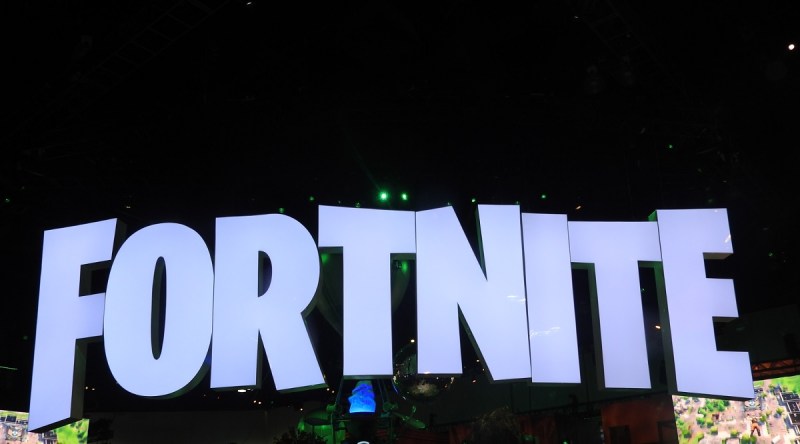
Above: Fortnite booth at E3 2018.
GamesBeat: Would it be good enough to deliver just Fortnite through that cloud?
Navok: To the point that Chris is making, why did we start the Flare project at Square Enix? Because Yoichi Wada said, “Let’s design the next Final Fantasy for the cloud.” What would that game look like? How would you monetize it?
Early: I disagree completely. Let’s say you can reduce the cost of serving down to zero. Let’s say whatever happens, your black hole computing and distribution works, whatever. It’s now zero cost to distribute a game to the device. Don’t you think there’s some amount more than the 120 million people that are playing Fortnite now, more like the 2 billion people who now have smart devices, who’d start playing the game? I’m talking about a remote compute version streamed to a screen they have, whether it’s this size, tablet size, or 75” HDTV size. This is the question. Is that going to expand the market or not?
GamesBeat: There are two companies that can deliver that, right? At zero cost. It’s Google and Amazon. They’re interested in this space.
Early: Zero because they subsidize it. But I don’t even think it has to be zero cost, because we all know the business model of digital sales today is roughly 70-30, right? 70 stays with the publisher, 30 goes to the distribution channel. Can they build a business that streams based on 30 percent of the target price of whatever we’re building?
Boxer: I wanted to go back to the content. We’re on the pre-deployment side. We’ve seen hundreds of studios. The studios that are building what you’d call cloud-first games – they’re in the cloud as a studio, with their development and engineering pipelines — they’re talking about Twitch being part of the process. It’s not an add-on.
We’ve found that even the small shops, they’re living in Amazon. They’re focused on branding experiences. We’ve found that a lot of studios that are migrating to the cloud, half their stack is in the cloud, it doesn’t really matter — that subset that’s not cloud-first, they’re making completely different games. They’re focusing on classic high-def triple-A games. Then you have these other studios that are branding experiences. They’re looking at Amazon as a way of taking their resources and making a brand new experience. That new experience, if it marries with a business model….
Audience: But that last part is what everybody says — that is the thing — a dollar an hour. Fortnite is being played, on average, 100 hours per user.
Boxer: I’m just saying that the studios, the production, if they’re not focused on a new way — cloud computing, instead of just the transmission side, the download — I’m saying that the growth there, the exponential growth that’s happening — this is what Amazon’s saying, what Microsoft is saying all the time. How do you create a brand experience and take advantage to do things that you could never do?
Navok: That was the core thesis we had. Those experiences — you mentioned Twitch. That’s where the last gamer is, actually. It’s people who just watch Twitch right now because they don’t have time to play. The moment you give them buttons to mess around with things, those studios all over the world, triple-A publishers, indie publishers — I was at dinner with a Chilean studio last night that’s doing integrations into Twitch right now. They’re starting to add these features into it where the streaming becomes interactive.
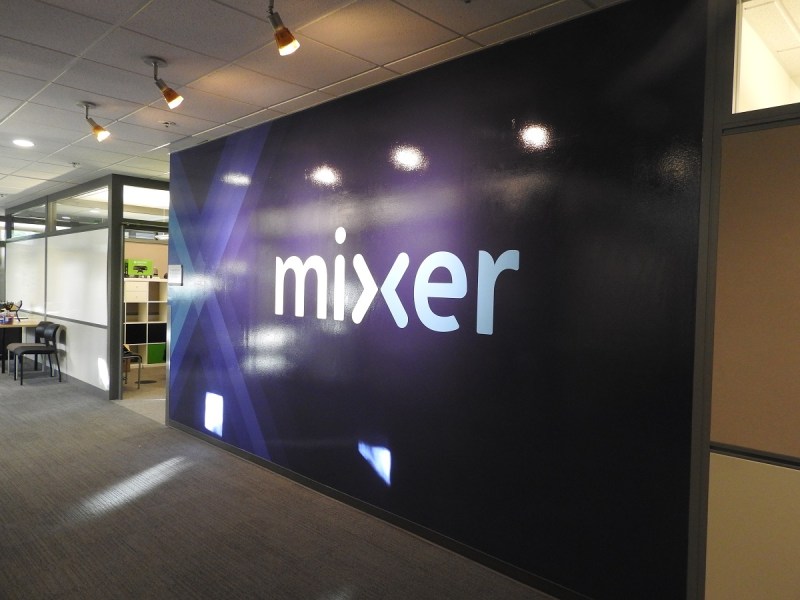
Above: Mixer wall in Redmond, Washington.
GamesBeat: Mixer integration, things like that?
Navok: Exactly.
Tops: I wanted, again, just because we’re heavily focused on the pre-production side, we talked to Amazon and the Lumberyard team and the stuff they’re doing with Game Stack. Their five or 10 year vision is incredible. Cloud gaming is something that’s strategic for them. They’re talking about driving bandwidth, services, all that kind of stuff. They’re trying to build a next generation of studios. What’s interesting about is that these studios — from the people to the tooling to the methodology of when you consider certain services in that pre-design phase, the concept art and all that — it’s very different from what I would call a mainstream, classic studio.
To me, those are going to be the experiences, when you launch them in the cloud — again, married to the right business models, that’s going to change the game, versus this incremental process of delivering Tomb Raider on a new device.
GamesBeat: John Smedley joined Amazon, and recounted Jeff Bezos talking to the game group there and saying, “I don’t care what you do, just make games with ridiculous computation.” If you remember, Microsoft had their cloud gaming initiative for Xbox One. They brought in the ability to use the cloud in games, doing things like having four million stars in a game instead of just 40. There are interesting ways to architect games for the cloud.
Tops: We thought about this conceptually, but we decided to focus elsewhere as a company. But hybrid compute, doing these ridiculous compute things — maybe in 10 years? I don’t know. But hybrid compute, once you get developers in the pipe — you can do hybrid compute where part of the rendering is in the cloud and part of the rendering is on the device. If you start developing content on that level, the experience isn’t always easy, but I think the guy that does that and does it well—a mobile device is pretty good. You can slash the costs of the entire thing in half. Then all of a sudden you’re playing a very different game than everyone else.
Early: Seeing some of these studios, five or 10 people — they’re looking at using services to come out with incredible AI, amazing things. The games that come out of that — cloud gaming is for that. Only games in the cloud will be up here. Then there will be other classic games. That’s what I think is going to create the big push.
Navok: The exact pieces that we’ve had for years now.
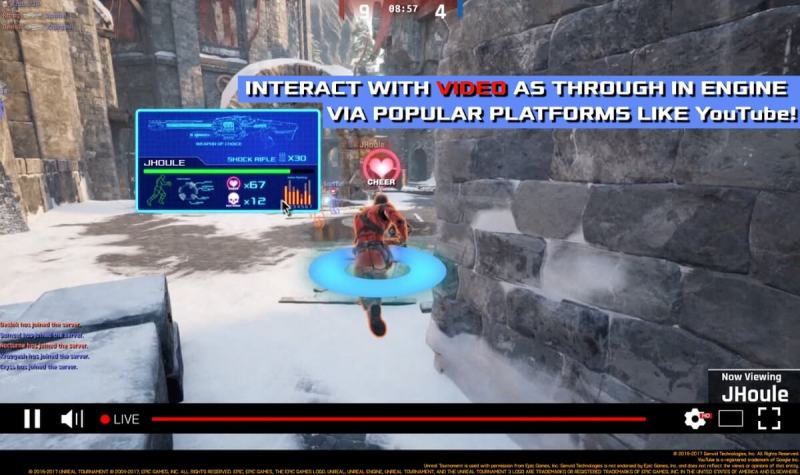
Above: Genvid lets you interact with video so that you can follow a player in an esports broadcast.
GamesBeat: Jacob, can you talk more about the esports interactivity you’re bringing? You have a different way to get people to benefit from the cloud.
Navok: Absolutely. My company allows for a spectator mode to be deployed on a server, and from that we can scale data up. We can write that data locally through an overlay that allows you to interact with it in real time, without feeling any latency. You can click on YouTube and Twitch videos as though you were playing the game. We do that all through spectator camera footage, which means we can create the perspective that we want.
If you look at every triple-A publisher right now, and a lot of the indie studios, every one is trying to understand how to create broadcasts that are fundamentally interactive, that engage viewers and monetize those viewers. That monetization part is what esports is all about. That’s what people fundamentally misunderstand.
Tops: But it doesn’t have all the economics, right? It’s one server?
Navok: We don’t have to deal with cameras. I had three fundamental problems. The cost of rendering is too high, cost of real time bandwidth is too high, and the latency just wasn’t there. Instead of having to create a rendering instance per user, I can create one that people broadcast. If I can utilize Twitch bandwidth, I can solve that problem. Finally, if I can synchronize to Twitch video I can solve the latency issue.
If you look at what esports is — at Square Enix I sold Final Fantasy to Joe. Joe streamed it to Twitch. Twitch made a billion dollars off of that, taking the entire value of that ecosystem. If Joe’s a partner Joe made some money off of it. As a publisher, we didn’t participate in that. We were told that was marketing. If you look at what esports is, and if you look at what Activision Blizzard’s movements are like, what everyone is doing, that is the start of publishers going back and taking value from that ecosystem and saying, “We’re going to generate broadcasts. We’re going to monetize broadcasts. We’re going to own viewership here.”
The more that they add interactivity to those streams, the more that those streams become closer to the cloud and create new experiences that can be monetized. When you capture that viewership you capture that monetization. You’re capturing the monetization of that last player who was just watching the stream. You’re adding steadily lower latency. If you look at the stuff that Mixer did with ultra low latency interactivity, that’s a cloud game for all intents and purposes. It will match and will mix. That’s what esports is. It’s steadily coming back to that first period.
GamesBeat: So cloud gaming enables publishers to take back some revenue that others have been getting?
Navok: Precisely.
Audience: What does monetization look like in this situation, though?
Navok: What I’m looking at is the idea of a micro-engagement, where for example, if you’re watching a stream and you want to press a kill button, somebody dies and you spend a buck for that. The viewer is now an antagonist. You enter the arena knowing that the people watching may mess with you. It’s a new form of content.
Imagine, for example, that at Thursday night at 8PM, you’re watching something like the Running Man or Smash TV in real time. Somebody calls to the viewership, “Come on down, you’re going to play,” and you have a controller instantly. Every other viewer gets to mess with you, control the enemies, fight against you. It’s like what HQ Trivia could be. Is this a cloud game? Is it an interactive broadcast? It’s a new form of entertainment.
That’s where I think this can go. When you talk about what developers are working on, this is the start of it. The more that they leverage Twitch and offload computational rendering, offload cloud gaming, it all goes back to this. This is the beauty of what cloud is. It’s taking advantage of rendering power, computational power, and interactivity for that 2 billion people, but giving new business models, which is to say the ability to monetize these last people and the ability to engage these last people in a new way.
Audience: Someone pointed out to me once that in sports, in football or basketball, the amount of hours watched versus the amount of hours played is totally inverted. A lot of people watch the game who don’t play. How do you see this in the future of the games industry? A lot of these companies are in the business of selling units, but what happens if you have a game that’s pretty hardcore, but it’s really fun to watch, and there’s an elite group of maybe a couple hundred players, and then the entire monetization is through esports?
Navok: Right. In sports, I can’t get to the level of a major league baseball player, but I can watch them.
Audience: Is that game going to come along?
Navok: In the next two years.
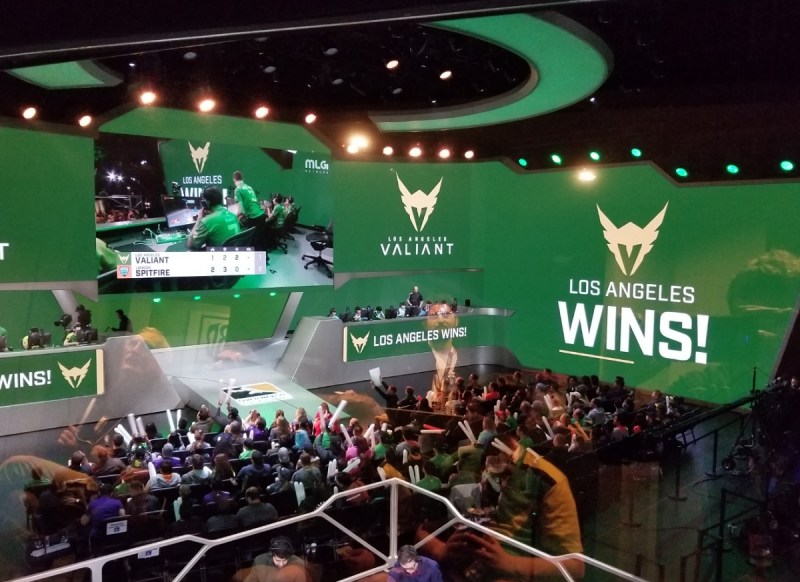
Above: LA Valiant at the Overwatch League.
GamesBeat: The analogy feels like the publishers are trying to make money selling footballs. They’re not making money off of an ESPN broadcast.
Navok: Correct. That’s exactly the thinking that I’m talking about. The MLB doesn’t sell baseballs. At the same time, the publishers sell baseballs. If you look at the ways in which the esports equation is working, if they can begin to monetize viewership, all of a sudden you have a shift from a $120 million ecosystem into a $200 billion ecosystem, because now you’re monetizing people who you haven’t monetized before. That’s what solves the cost equation.
Tops: If you talk to Amazon — for them, Twitch and all that, that’s a game.
GamesBeat: Chris, how do you feel about selling baseballs?
Early: Frankly, it sucks as a business model. [laughs]
Navok: But you can also create businesses around other monetization opportunities. Again, the industry expands. It doesn’t shift.
Audience: Does anybody in the room see standards developing? What are those standards, and on what timeline do you think the industry will embrace them? Right now it seems like it’s pretty bifurcated. People are doing their own thing at each company.
Navok: I think the standards are actually going to be those streaming platforms. I see them as the future consoles, to the point that you’ve been making. I see YouTube, Twitch, Douyu in China, these are the things that you will operate off of because the customers are there. And then certain large publishers will own and operate their own platforms, streaming and broadcasting inside them. You’ll see that from Activision Blizzard. There will be alternatives to the set standards.
Think of it like what happens with engines today. EA and Activision create and own their own game engines. Other studios use Unreal and Unity. Depending on where you are in the ecosystem, you either use Twitch and YouTube, or you use your own.
Audience: Again from the perspective of standards, if you want to bring your game to the cloud, is there going to be a standard way to do that? Right now that’s totally nonexistent.
Audience: This is one of the challenges that OnLive faced. Even if it was a perfect solution, it still took a bunch of work to make your games work there. Maybe it’s scalable for one platform, but the second and the third and the fourth and the fifth….
Audience: That’s one of the advantages, why we went with Windows, because the games are already there. Everybody’s already building for it. For a game developer, if you build on Windows, you’re everywhere. You don’t have to deal with 100 different versions. To what we were saying earlier about Fortnite on mobile, Fortnite on mobile is not the same game as Fortnite on PC. It’s not the same experience. It’s very similar. But other games are even more different. The mobile version is a toned-down version, a bastardized version of the real game.
Tops: I totally disagree with that. What they have to do is make a totally different game, because the experience on the phone….
Audience: Sure, sure. To your point, if you want to port everywhere, cloud can do that in a way that’s been promised before, but it’s never been provided. On the experience side, we have thousands of graphics cards. If your game requires four of them — I saw an Nvidia demo of their new ray tracing technology that looked exactly like Star Wars. If your game requires four graphics cards, maybe you can charge customers more to play your game. That’s okay. Why should I have to pay $50 for a game, bring it home and realize it’s crap, and then pay $50 for a different game and play 10,000 hours of that? Why wouldn’t I pay more for the 10,000 hour game? That’s how you can monetize. In terms of development and distribution and monetization and new experiences, these platforms allow you to do that.
Early: We look at everything as a return on our development time. If we want to go and make that cloud game that’s totally tailored for that kind of experience, our addressable market is tiny. We can’t afford to do that. We can maybe start to iterate a little bit on some of our games, if we have some elements that start to work more. That’s what Microsoft did with Titanfall. They used cloud compute for the stars, for some of the AI. That’s incremental. That’s a broadly distributed consumer-adopted technology. We can’t afford to make that game.
Navok: How do you marry that with the idea that streams can work anywhere? Isn’t the addressable market instantly solved by the fact that that experience is available to so many?
Early: The addressable market for us are the people that are using the platform today. You have an addressable market—how many Netflix players are installed? That’s the addressable market for streaming video. We don’t have a game player, just to use the word, that’s distributed on that many platforms that I can make a game for.
Navok: That’s what I mean when I talk about an industry portal. We’re missing the customer acquisition funnel. I agree with that.
Audience: I think we’re stuck in a chicken and egg problem. We need to have more users to distribute content to, but….
Navok: It starts like Steam started, right? They started out with Half-Life 2.
Audience: What it takes is that big triple-A title. It’s what Oculus needs to start their funnel.
Early: There could also be an evolution in the customer base, which is the Steam point. This could happen from a streaming standpoint as more and more people — obviously I’m going to pick on your service—these people adopt your service, and suddenly you have 5 million people playing that. Some people are going to start to say, “Maybe I can do something for that.” Then we combine your five and GeForce Now’s five, and somebody else’s five — the numbers are going to get to a big enough number that maybe there’s a game that can be made directly for this platform. In the meantime, I’m going to sell the games I make now to this five. Now I’ve opened up my market further. But how do we get to the place where that player, that customer, can get a streamed game in enough places that we can start to make content for that?

Above: Twitch emphasized its community during a keynote presentation today.
Navok: My perspective is, from pure cloud, that’s not there yet, although it’s probably going to be one of the big players, Microsoft or others, that create those portals. For the incremental elements, Twitch has 100 million. If you build it and operate on Twitch….
Early: That’s the closest we are to the mix of technology and model. There’s a whole side of the HD games that we make that is new in the last 10 years. It’s the viewership side. It’s not the play. It’s the rest of it. It’s the not selling the baseball part, which is a great problem overall.
Navok: It’s a great opportunity.
Early: Exactly.
Tops: There’s already a plethora of games for which, in the right circumstance, there’s already the right business model to be made. My belief, after being in the business and failing as well, is that you need to have frictionless models. We built our entire business model on the fact that no developer needs to do anything to run their content on our platform. Now that I know this, and this is why I’m interested in cloud gaming — we don’t need to do anything to publish to the cloud. We have a distribution agreement. They don’t care how we distribute it.
Early: You have a couple of our games on your service. And the challenge, unfortunately, for us is the business model. Not the technology.
Tops: But the business model will grow, because cloud gaming needs a size model, in my view. Cloud has a continuous cost. That’s the way it works. It has constant operating costs. You need to replace stuff. The ideal situation, the pipe dream, is that nobody owns a console anymore. Everyone just has a thin device, everybody lives on that thin client, and everything goes into the cloud, because then there’s no more need to buy expensive hardware. All the heavy lifting is done off site. That’s the endgame you want to move toward. Right now we’re in a very different universe.
GamesBeat: Amazon and Google are okay with that.
Tops: To the business model question, that’s more a matter of scale, and some other creative modeling that we’re working on. But it’s always — you have to first grow that model. Subscription gaming is very new. You have to grow that model. I think cloud gaming is a way to grow that model, because you can address that other market, but also the existing market. From that growth, essentially, there needs to be the spark of a business mode.
Early: I’m not sure about the interim phase. There’s a future state that we kind of talked about here, and there’s a today state. I actually view subscription gaming as inhibiting our progress, and I’ll give you two examples. One is with PS Now. I think that’s a great technology for getting streaming content to people, but we don’t make the money as a publisher — we don’t make the same amount of money as we would even just putting stuff on sale. So why bother, from a publisher’s standpoint?
The technology is great for a player. I can play anything anywhere instantly! It’s awesome technology, which is inhibited by the business model. So charge a PlayStation Plus add-on to be able to stream any game you own to any device you own. That’s a great service for the player. It’s going to start people adopting that streaming concept in more places. You’ll be able to get to a place where you have more people focused on streaming.
There’s a similar challenge with your business model. We see it works. We’re believers. You’ve capped it with a subscription plan, where publishers aren’t able to make money. On the other hand, you could just sell the game and let people have the five-minute experience while it downloads, or pay you an add-on price to be able to continue to have fast access in many more places. With subscription it’s just giving it away.
Disclosure: Akamai funded our breakfast event. Our coverage remains objective.
